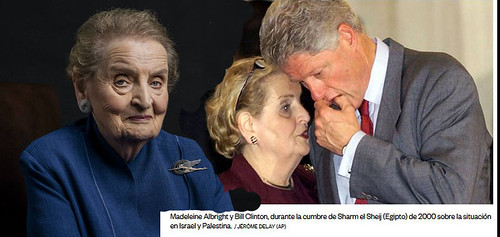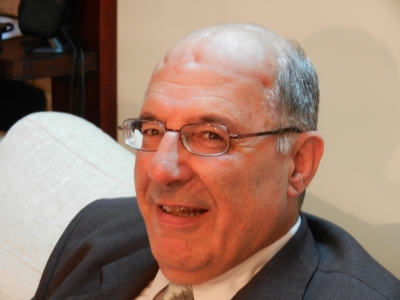
Bill Clinton and Madeleine Albright
(Image by rupertomiller@hotmail. 6672 6121 hijo 66852945) Details DMCA
International Criminal Tribunal for the former Yugoslavia (ICTY) Investigations: Interview with Chief Investigator Jean Rene-Ruez [*]
Ruez makes a correct point that "there is no crime without the body, and this investigation was commenced as a crime without a body." Excavations of suspected Srebrenica mass graves did not begin until 1996, a full year after the event, and over the following years they yielded an extremely modest body count in relation to the politically anticipated toll of 8,000 "genocide" victims.
The little noted and barely commented interview that the ICTY Prosecution's Chief Investigator Jean Rene-Ruez gave to the journal Cultures & Conflits is very conducive to a better understanding of how Srebrenica evidence was collected and used, as well as the criteria that guided the process. The interview was published in the spring issue of the journal in 2007, after Ruez's retirement from the ICTY. As is often the case in similar situations, actors tend to be more open and give more useful insights after leaving their posts.
Ruez's background is very interesting and probably influenced his approach. He is Alsatian (a historically contested Franco-German border province) and is the product of a mixed marriage. It is reasonable to think that the German aspect of his heritage, accompanied by the guilt complexes generated by the Second World War and the resulting need for "atonement", may have dictated in part Ruez's condemnatory zeal for the "genocide in Srebrenica" and influenced some of his more severe assessments. Nevertheless, his fundamental intellectual honesty cannot be disputed, as many of the disclosures he made in this interview attest.
In section 2 of the interview, Ruez makes in passing the revealing observation that "the investigation began in Tuzla on July 20." The chronology is of some significance because the condition precedent for the crime occurred on July 11, and the crime itself began to unfold on July 14. Elsewhere, Ruez states that he received orders to proceed to Tuzla on July 17 [Le Point, 26/05/2008 NÂ degrees1862] Even by July 20, when he set to work, no one had any inkling of its nature or dimensions. There was a total lack of any hard information that would suggest in relation to the aftermath of the fall of Srebrenica an affair of extraordinary dimensions. That makes the hasty dispatch of the Chief Investigator to Tuzla, to conduct inquiries that only five days later, on July 25, resulted in genocide indictments brought by ICTY, extremely interesting. One need not take a conspiratorial view of the matter and call it suspicious, but interesting will certainly do.
In section 6, Ruez makes a comment regarding the armed Bosnian army column which conducted a military style breakout from Srebrenica to Tuzla. He says that matters related to the column were "not part of the investigation", that "6,000 of them rejoined the Bosnian forces after the breakout" (a figure considerably higher than General Enver Had�... �ihasanoviÄ"�'s admission of approximately 2,500), and concludes significantly that the combats along the column's path "are part of military history, not a crime dossier." Why is this important? Because of the enormous number of casualties that the column suffered, the mortal remains later having been collected by ICMP and associated friendly agencies to be presented, precisely, in the context of a "criminal dossier," as victims of illegal execution and therefore genocide. Nevertheless, neither ICTY nor the Sarajevo War Crimes Court have indicted anyone for inflicting casualties on the armed column, and there are sound legal reasons for that. Ruez explains that position with perfect clarity and effectively drives that important point home: the men in the column "ought to be considered as having been killed in combat and they are excluded from the calculation of execution victims, the latter having been previously captured by the Bosnian Serb army."
Further on, in sections 30 and 32 of the interview Ruez mentions a subject which is potentially of capital importance, but which has received no attention whatsoever: contemporaneous witness statements. In section 30 he asserts that the Sarajevo Research and Documentation Center of Mirsad TokaÄ �a, now defunct but fully operational at the time of the interview, had assembled "a stock of 600 witness testimonies." In section 32, he says that "in the latter half [alternatively, "at the end of"] July, upon arriving in the area, we have a reserve of 1,200 potential testimonies, half-page debriefings, maximum of one page per person." Where are these approximately 1,800 statements that potentially could shed valuable first-hand light on important events and furnish historians, jurists and other professionals much additional information? Where and in whose custody are they stored? These important questions have not been raised or ventilated at any of the several Srebrenica trials that took place after Ruez made these disclosures in 2007. The comprehensiveness and accuracy of our assessment of subject events are greatly diminished as a result of these documents' inaccessibility.
In section 37, Ruez makes a correct point that "there is no crime without the body, and this investigation was commenced as a crime without a body." Excavations of suspected Srebrenica mass graves did not begin until 1996, a full year after the event, and over the following years they yielded an extremely modest body count in relation to the politically anticipated toll of 8,000 "genocide" victims. That began to change only with the abrupt introduction of DNA technology several years later, which miraculously facilitated a drastic expansion of the "body count." However, in relation to the circumstances of his hasty deployment to Tuzla, in mid-July 1995, Ruez's observation about a "crime without the body" remains strikingly intriguing.
Finally, in sections 48 50, Ruez makes what is potentially his most significant disclosure. He says that, first of all, the greatly advertised "satellite photos" are nothing of the kind but are shots made by U2 spy planes, which were by that time (remember the famous downing of a U2 plane over the Soviet Union in 1960 which caused the failure of the Paris summit conference) virtually obsolete. That does not necessarily invalidate the photos, provided they are properly tendered into evidence and can be forensically examined by the defense. But what follows is a clarifying remark of great resonance. "Theoretically," Ruez asserts, "anyone being able to view this image would know what is going on in the area. But in practice, the image is impossible to interpret [or, "read"] unless one already knows what one is looking for and has cross-compared the image with observations carried out on the ground."
"The image," he clarifies, "by itself has no precise meaning and could even become a source of great errors of interpretation" (Section 49). In section 50 he goes on to illustrate this point by analyzing the informativeness of Madeleine Albright's performance at the UN Security Council on August 11, 1995, when she tantalizingly waved some images she claimed were Srebrenica mass grave photos, but without allowing anyone to come closer and examine them.
Again, without voicing any undue suspicion, it is still possible, and even sensible, to view the totality of these remarks as extremely interesting. Assuming NATO had any images whatsoever of Srebrenica executions made from an aerial platform, whether satellite or U2, we learn from Ruez that without supplementary information from sources on the ground these images would have remained rather uninformative. What sources on the ground then, capable of making "observations effectue'es sur le terrain," did NATO have in the days Srebrenica killings were going on (roughly July 14 17) that allowed its intelligence experts to correctly assess what the images purported to show and to conclude that a mass killing operation, warranting an immediate inquiry by Chief Investigator Ruez, was occurring on the ground below? Is this merely another "interesting" factual observation by Chief Investigator Ruez, or is it a Freudian slip?
***
[*] See Culture and Conflicts for full interview: https://journals.openedition.org/conflits/2198
ICTY investigations. Interview with Jean-Rene' RuezThe Inquiries of the ICTY.
summariesNext Page 1 | 2 | 3 | 4 | 5 | 6
(Note: You can view every article as one long page if you sign up as an Advocate Member, or higher).





